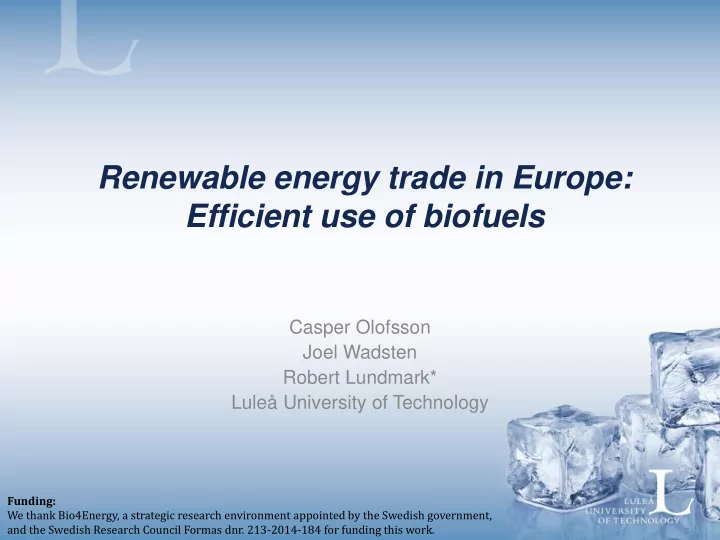

Renewable energy trade in Europe: Efficient use of biofuels Casper Olofsson Joel Wadsten Robert Lundmark* Luleå University of Technology Funding: We thank Bio4Energy, a strategic research environment appointed by the Swedish government, and the Swedish Research Council Formas dnr. 213-2014-184 for funding this work.
Introduction Trade with forest products can help to achieve national targets on renewable energy and emission levels by increasing the efficiency The purpose is to estimate a trade model of forest biofuels in order to project and assess future trade patterns up until 2020. A gravity model is developed and implemented on EU28 countries for the period 2005-2014. The study includes woodchips and particles (HS4401) and an aggregated industrial roundwood (HS4403)
Forest biofuel in Europe 4.000 3.500 3.000 2.500 Million m 3 2.000 1.500 1.000 500 0 Standing forest in EU28 in 2010 (million m 3 ) Source: Eurostat (2017).
Forest biofuel in Europe 12 10 8 Million m 3 6 4 2 0 Production of wood chips and particles in 2015 (million m 3 ) Source: FAOSTAT (2017).
Projected GDP development 4.000 Germany 3.500 3.000 United Kindom Million Euros 2.500 France Italy 2.000 1.500 Spain 1.000 Netherlands Note A 500 0 2005 2006 2007 2008 2009 2010 2011 2012 2013 2014 2015 2016 2017 2018 2019 2020 GDP development for the period 2005-2020 (million Euros) Source: IMF (2017). Note A: In descending order Poland, Sweden, Belgium, Austria, Ireland, Denmark, Finland, Romania, Greece, Portugal, Czech, Hungary, Slovakia, Luxemburg, Bulgaria, Croatia, Lithuania, Slovenia, Latvia, Estonia, Cyprus, Malta .
Gravity model The trade gravity model has become a commonly used empirical method to evaluate and predict trade patterns There have been a few attempts to apply the gravity model on forest biofuel trade 𝛾 1 𝑍 𝛾 2 𝑍 T is the trade flow in monetary terms for trading partner i and j 𝑗 𝑘 A is a constant (across cross-sections) 𝑈 𝑗,𝑘 = 𝐵 𝑗 Y is the magnitude of the economic activity 𝛾 3 𝐸 𝑗,𝑘 D is the distance β ’s are unknown parameters. The equation can be linearly estimated by transforming the equation into logarithmic form.
Gravity model A common border dummy ( BORD ) and a common currency dummy ( EURO ) are added and they are both expected to affect trade positively An forest endowment variable (END) is also and is expected to affect trade positively The model is estimated as a fixed-effect panel data model using robust estimation of the s.e. to account for possible heteroscedasticity or within-group correlation
Data The data set include 15,120 observations The data on trade value and forest endowment are collected from FAOSTAT. Trade value is measured as annual export values in thousands US dollars from each reporting country to each partner country. The values has been converted into constant 2005 Euros The income variable is measured by Gross Domestic Product (GDP), which is collected from the IMF database The distance variable is measured as kilometers between the capital cities
Results Econometric results Augmented Dickey- Woodchips and particles Industrial roundwood Variable Fuller and Phillip- Coefficient Coefficient Perron tests are 0.64 *** -0.69 *** performed to test for Y i (0.17) (0.22) unit root and the null *** *** 0.36 0.80 hypothesis can be Y j (0.01) (0.02) rejected. *** *** -1.06 -1.54 D (0.04) (0.05) * *** 0.22 0.44 END (0.11) (0.15) *** *** 3.31 3.04 BORD (0.08) (0.11) *** *** 0.17 0.41 EURO (0.05) (0.07) R 2 57.5 60.5 ***, **, * indicates a statistical significance of the coefficients at 1%, 5% and 10% level, respectively. Standard error in parenthesis
Results 400 Trade forecasting results 350 300 Million Euros 250 2014 200 Actual Forecast 150 100 50 0 2005 2010 2015 2020 120 Forecast of wood chips and particles trade value, 2015-2020 Finland France Germany Sweden 100 80 Million Euros 60 40 20 0 2 0 0 5 2 0 1 0 2 0 1 5 2 0 2 0 Forecast of wood chips and particles trade value for Finland, France, Germany and Sweden, 2015-2020
Conclusions A common currency is affecting trade as much as forest endowments Proximity between trade partners still a major determinant Aggregated trade value of woodchips and particles are projected to increase by almost 100 million Euro until 2020, corresponding to a 29.3% increase The trade values are projected to increase by almost 2.9 and by 2 million Euros for Sweden and Finland, respectively. For France and Germany the trade value is projected to increase by 9.6 and 13.8 million Euro, respectively
Contact information Professor Robert Lundmark Luleå University of Technology Economics Unit SE-971 87 Luleå, Sweden Email: Robert.Lundmark@LTU.se
Recommend
More recommend